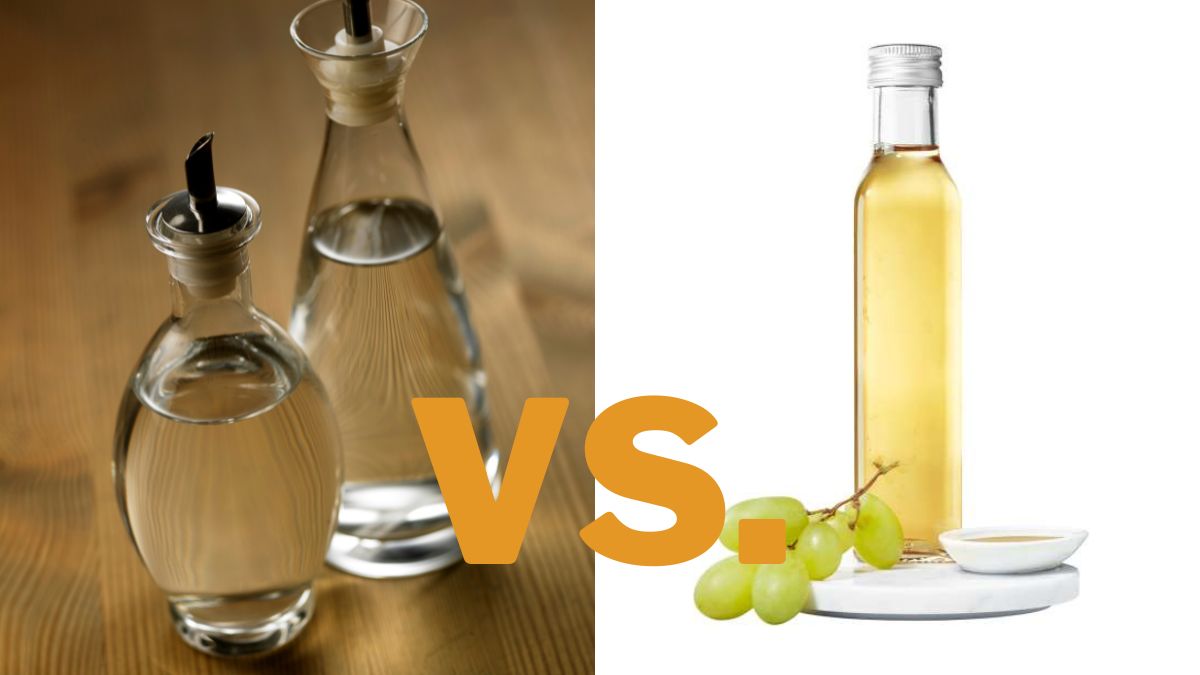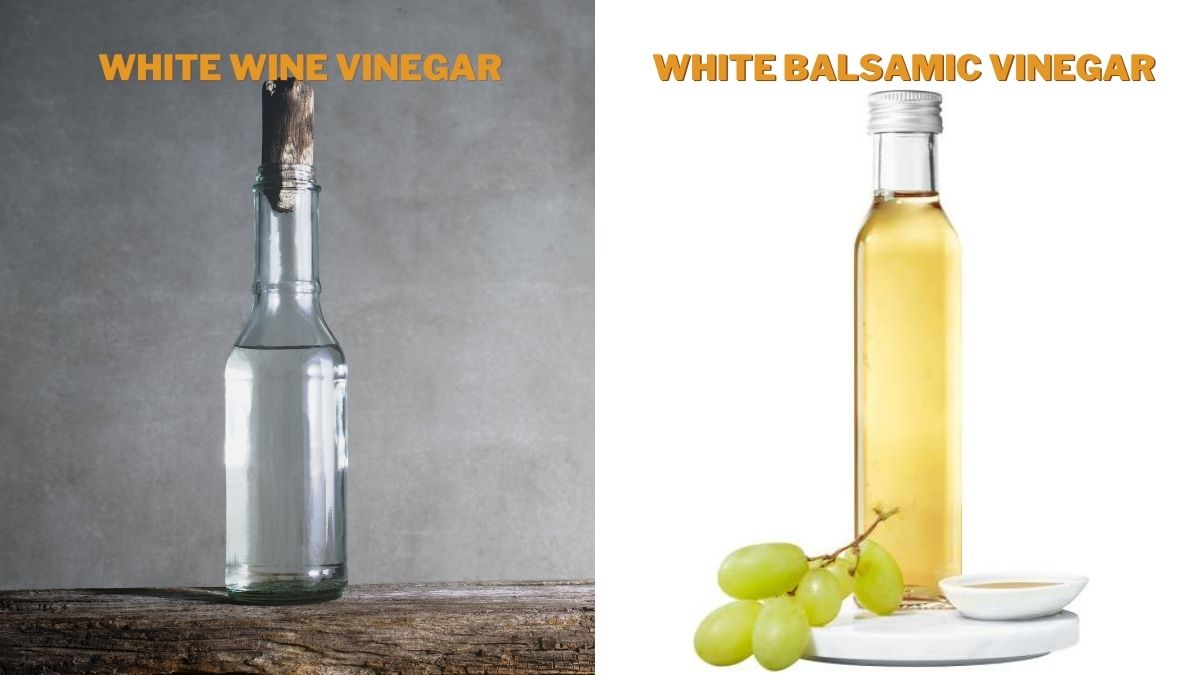White Wine Vinegar vs. White Balsamic Vinegar: Differences & Uses

Although they may seem similar, white wine and balsamic vinegar are different. I use both white wine vinegar and wine balsamic vinegar for many purposes in the kitchen, from dressings to simply giving flavor to food and even used for cleaning. Both are kitchen staples in my kitchen. Even though their uses may overlap in one part, they are not completely interchangeable. So, what are the differences between white wine vinegar and white balsamic vinegar?
White wine vinegar is made from white wine; white balsamic vinegar comes from grape juice. The different base materials make these two kinds of vinegar differ in flavor and purpose. White wine vinegar is tart and sour, while white balsamic vinegar is sweeter and thicker.
Using white wine vinegar and white balsamic vinegar in the wrong way can seriously impact the flavor of your dish, so proper use of these two is an absolute must. To help you make the best of your white wine and white balsamic vinegar, in the following paragraphs, I will describe them in detail and let you in on some secrets on how to substitute for them.
What Are the Differences?
Although similar and in the same category, white wine vinegar and white balsamic vinegar are made differently and from different ingredients, which is the root of their differences.
Ingredients and Preparation
The fermentation makes white balsamic vinegar from grapes made from fruit juice. White balsamic vinegar ages for years in barrels, and it has a golden-yellow color. It is not very acidic, and depending on the brand, it varies from 5-7% acidity.
White wine vinegar comes from fermenting white wine, which is lighter colored than white balsamic vinegar and more acidic.
Flavor
Due to the different base materials, the flavor is probably the most significant difference between white vinegar and white balsamic vinegar. Due to its higher acidity, white wine vinegar is the sour and more intense flavor of the two.
It is still fruity and grapy; it is also tangy and has a very slight and soft but noticeable alcoholic whiff. It tastes a little like white wine, though the white wine influence is more palpable on the nose than the palate.
To like the flavor of white wine vinegar, you need to develop a taste for it; otherwise, it won’t sit well with you. Nevertheless, it is soft and pleasant. Still, since no one drinks white wine vinegar, but they mix it with food, the flavor alters and adapts to the already existing flavors in the meal.
White balsamic vinegar is a little denser than white wine vinegar. Considering that it comes from grape juice, it is sweet, mild, and gentle. The aging in barrels makes it mellow and more adaptive to other flavors.
It is slightly sour but not enough to overwhelm the flavor. It is mildly tangy and very soft.

Uses
Both white wine vinegar and white balsamic vinegar have wide applications, and they both go excellently in salads, dressings, sauces, and make amazing meat marinades. However, white balsamic vinegar requires mixing with other ingredients to work better.
White wine vinegar goes perfectly in vinaigrettes or is poured directly into the food. It is often used in salads, soups, and cooking. My favorite are sauces made using balsamic vinegar, honey, mustard, sour cream, etc. — also, these are the best way to use white balsamic vinegar.
Furthermore, I adore adding both of them to sandwiches; you just have to know how to combine them perfectly! Look at how easy it is to incorporate them and make the most delicious sandwich!
Availability
Availability is no issue for both of these types of vinegar. They are available in retail and wholesale stores, online, chain stores, and also small local shops and supermarkets.
Popularity
White wine vinegar seems to be more popular in general, as it has a wider application than white balsamic vinegar. Nevertheless, there are instances where white balsamic vinegar is irreplaceable. White balsamic vinegar is more prevalent in gourmet cooking and fine dining.
Furthermore, white wine vinegar is the most popular kind of vinegar, so it seems that no other vinegar is a good competition. Still, white is very popular too, but it has a slightly different audience than white wine vinegar.
Also, white wine vinegar is more popular in households, while white balsamic vinegar is more prevalent in restaurants.
Here are all the differences summarized in a video!
Can You Use White Balsamic Vinegar Instead of White Wine Vinegar?
White wine vinegar has a wider application than white balsamic vinegar, so it is a little harder to substitute for it. White balsamic vinegar is a good substitute for white wine vinegar in vinaigrettes, salad dressings, sauces, and perhaps certain dips.
However, white wine vinegar isn’t only good for mixing in sauces and dressings, but it is also used on its own in cooking and salads, with nothing more than salt and pepper. White balsamic vinegar is not the best substitute for white wine vinegar in these situations.
Still, using white balsamic vinegar instead of white wine vinegar in cases where you would white wine vinegar on its own isn’t the worst idea; I would just never do it in cooking.
Can You Use White Wine Vinegar Instead of White Balsamic Vinegar?
Yes, white wine vinegar can easily be substituted for white balsamic vinegar. It fits nicely instead of white balsamic vinegar, but it does change the flavor, though not considerably. White wine vinegar is more widely used as it goes great with sauces, dips, and dressings.
A dressing made with white wine vinegar instead of white balsamic vinegar is a little thinner and slightly more acidic. Furthermore, it is slightly more string in taste, but I usually fix this easily by adding a smaller amount of white wine vinegar.
Generally, white wine vinegar substitutes for white balsamic vinegar better than vice-versa.
